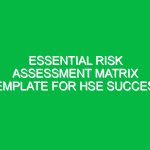Introduction
In today’s complex industrial landscape, effective Health, Safety, and Environment (HSE) management is paramount. One of the foundational elements that ensure a safe working environment is the use of robust risk assessment methods. These methods are essential in identifying potential Hazards, evaluating associated risks, and implementing appropriate Control Measures. This article explores various risk assessment methods relevant to the HSE domain, emphasizing their importance in fostering a culture of Safety and Sustainability within organizations.
Understanding Risk Assessment Methods
Risk assessment methods are systematic processes used to identify, evaluate, and prioritize risks associated with workplace activities. These methods are designed to protect employees, the environment, and the organization itself from potential harm. In the HSE context, risk assessments help organizations comply with legal requirements, reduce accidents, and enhance overall Safety performance.
There are several key aspects to consider when discussing risk assessment methods:
- Identification of Hazards: Recognizing potential sources of harm is the first step in any effective risk assessment.
- Risk Evaluation: This involves determining the likelihood and severity of risks associated with identified hazards.
- Control Measures: After evaluating risks, organizations must implement strategies to mitigate them.
- Monitoring and Review: Continual assessment of risks and the effectiveness of Control Measures is crucial for ongoing safety management.
Key Risk Assessment Methods
There are numerous risk assessment methods, each suited to different organizational needs and specific contexts. Below, we delve into some of the most significant risk assessment methods used in HSE management.
1. Qualitative Risk Assessment
Qualitative risk assessment is a subjective method that relies on the judgment of individuals or teams to identify and evaluate risks. This approach is often used when quantitative data is lacking or when rapid assessments are needed.
A practical example of qualitative risk assessment can be seen in construction sites, where safety personnel conduct walkthroughs to identify potential safety hazards. They may categorize risks into levels such as low, medium, or high based on their experience and observational skills. This method can be effective for quick assessments but may lack the precision of quantitative methods.
2. Quantitative Risk Assessment
In contrast, quantitative risk assessment uses statistical data and numerical values to assess risks. This method often involves calculations to determine the probability of a risk occurring and its potential impact.
For instance, in the chemical manufacturing industry, companies may use historical data on chemical spills to calculate the likelihood of future incidents and their potential Effects on both personnel and the environment. This method provides a more objective basis for decision-making but requires access to accurate data and resources.
3. Semi-Quantitative Risk Assessment
Semi-quantitative risk assessment serves as a bridge between qualitative and quantitative methods. It allows organizations to score risks based on a combination of qualitative assessments and numerical values.
For example, a risk matrix might be developed where risks are scored on a scale from 1 to 5 for both likelihood and severity, allowing for a clearer prioritization of risks. This method can be particularly useful in industries where both qualitative judgment and numerical data are available and relevant.
4. Bow-Tie Analysis
Bow-tie analysis is a visual risk assessment method that combines elements of both qualitative and quantitative assessment. This method helps organizations understand the relationship between risks and their control measures.
A bow-tie diagram depicts the causes of potential incidents on the left side and the consequences on the right, with control measures represented in the center. This visual representation aids in identifying gaps in Safety Measures and clarifies how specific actions can prevent incidents. For example, in an oil refinery, bow-tie analysis can illustrate how preventive Maintenance can mitigate the risk of equipment failure.
5. Failure Mode and Effects Analysis (FMEA)
FMEA is a structured approach for identifying and prioritizing potential failures in a system or process. This method is particularly effective in industries such as healthcare and manufacturing, where system reliability is critical.
In a healthcare setting, FMEA can be used to analyze processes related to patient care. By identifying failure modes (e.g., medication errors) and their effects, healthcare organizations can implement corrective actions to enhance patient safety. This method emphasizes proactive measures to prevent incidents before they occur.
6. Hazard and Operability Study (HAZOP)
HAZOP is a systematic technique used to evaluate the potential hazards associated with process operations. It involves a detailed examination of processes through team discussions to identify deviations from the intended design or Operation.
In a chemical plant, a HAZOP study might reveal that a certain pressure could lead to a hazardous reaction if not controlled. By addressing these deviations early in the design process, organizations can prevent accidents and ensure safer operations.
Benefits of Effective Risk Assessment Methods
Implementing effective risk assessment methods yields numerous advantages for organizations operating within the HSE domain:
- Enhanced Safety: By identifying and mitigating risks, organizations can create safer work environments, reducing the likelihood of accidents and injuries.
- Regulatory Compliance: Adhering to legal requirements related to health and safety can mitigate the risk of penalties and enhance the organization’s reputation.
- Improved Decision-Making: Data-driven insights from risk assessments allow organizations to make informed decisions regarding resource allocation and operational changes.
- Cultural Shift: Regular risk assessments foster a culture of safety and awareness among employees, encouraging them to actively participate in safety initiatives.
Real-Life Applications of Risk Assessment Methods
To illustrate the practical application of risk assessment methods, consider the case of a manufacturing company that implemented a comprehensive risk assessment strategy.
The company faced rising incidents of workplace injuries, prompting management to adopt a more structured approach. They began by conducting qualitative risk assessments during safety meetings, allowing employees to voice concerns about potential hazards. Next, they employed quantitative methods to analyze injury data, revealing that certain machines posed a higher risk.
Armed with this information, the company implemented engineering controls, such as machine guards and safety interlocks. They also conducted a bow-tie analysis to ensure that preventive measures were in place. Over the course of a year, workplace injuries decreased significantly, demonstrating the effectiveness of their risk assessment strategy.
Regulations and Standards Governing Risk Assessment Methods
Several Regulations and standards guide the implementation of risk assessment methods in the HSE context. Organizations must be aware of these requirements to ensure compliance and promote safety effectively.
- Occupational Safety and Health Administration (OSHA): In the United States, osha mandates that employers assess workplace hazards and implement appropriate control measures.
- ISO 45001: This international standard specifies requirements for Occupational Health and safety management systems, emphasizing the importance of risk assessment.
- Environmental Protection Agency (EPA): The EPA outlines regulations for assessing environmental risks in various industries, ensuring that organizations mitigate their impact on the environment.
Adhering to these regulations not only enhances safety but also protects organizations from legal repercussions and improves their public image.
Conclusion
In conclusion, effective risk assessment methods are indispensable tools for achieving excellence in health, safety, and environmental management. By systematically identifying and evaluating risks, organizations can implement appropriate measures to prevent incidents, protect their workforce, and contribute to environmental sustainability. The continuous evolution of risk assessment techniques ensures that organizations remain proactive in addressing emerging risks and challenges.
As industries continue to evolve, so too must our approaches to risk assessment. Organizations are encouraged to adopt a combination of qualitative and quantitative methods tailored to their specific needs. By fostering a culture of safety and continuous improvement, we can create safer workplaces for everyone.


